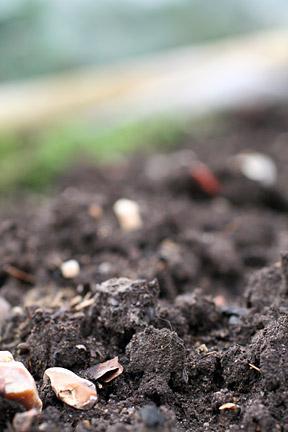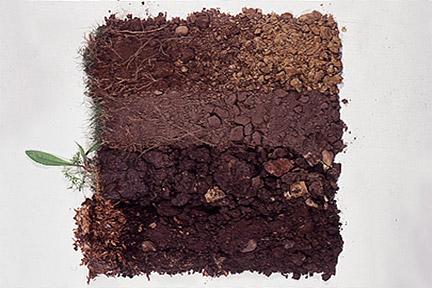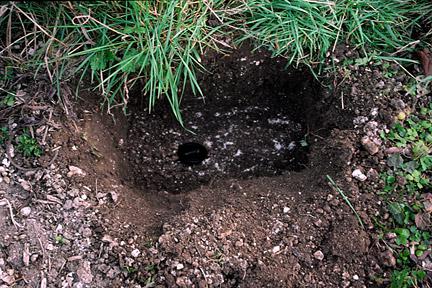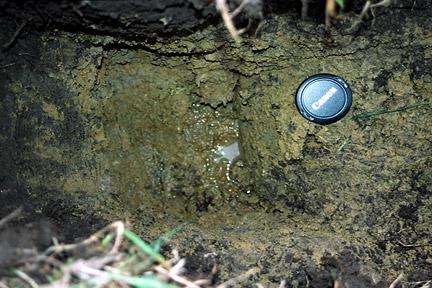Knowing whether your soil type is clay, sand, silt, loam, peat or chalk will help you choose the right plants for your garden and maintain them in good health.

Quick facts
Clay soils are heavy, high in nutrients, wet and cold in winter and baked dry in summer
Sandy soils are light, dry, warm, low in nutrients and often acidic
Silt soils are fertile, light but moisture-retentive, and easily compacted
Loams are mixtures of clay, sand and silt that avoid the extremes of each type
Peat soils are very high in organic matter and moisture
Chalky soils are very alkaline and may be light or heavy
Soils vary enormously in characteristics, but the size of the particles that make up a soil defines its gardening characteristics:
Clay: less than 0.002mm
Silt: 0.002-0.05mm
Sand: 0.05-2mm
Stones: bigger than 2mm in size
Chalky soils also contain calcium carbonate or lime
The dominating particle size gives soil its characteristics and because the tiny clay particles have a huge surface area for a given volume of clay they dominate the other particles:
Clay soils have over 25 percent clay. Also known as heavy soils, these are potentially fertile as they hold nutrients bound to the clay minerals in the soil. But they also hold a high proportion of water due to the capillary attraction of the tiny spaces between the numerous clay particles. They drain slowly and take longer to warm up in spring than sandy soils. Clay soils are easily compacted when trodden on while wet and they bake hard in summer, often cracking noticeably. These soils often test the gardener to the limits, but when managed properly with cultivation and plant choice, can be very rewarding to work with
Sandy soils have high proportion of sand and little clay. Also known as light soils, these soils drain quickly after rain or watering, are easy to cultivate and work. They warm up more quickly in spring than clay soils. But on the downside, they dry out quickly and are low in plant nutrients, which are quickly washed out by rain. Sandy soils are often very acidic
Silt soils, comprised mainly of intermediate sized particles, are fertile, fairly well drained and hold more moisture than sandy soils, but are easily compacted
Loams are comprised of a mixture of clay, sand and silt that avoid the extremes of clay or sandy soils and are fertile, well-drained and easily worked. They can be clay-loam or sandy-loam depending on their predominant composition and cultivation characteristics
Peat soils are mainly organic matter and are usually very fertile and hold much moisture. They are seldom found in gardens
Chalky or lime-rich soils may be light or heavy but are largely made up of calcium carbonate and are very alkaline
Where building or landscaping has mixed up different soils, it can be very difficult to tell what type of soil you have, and it may change markedly over a short distance.
Different soil types in vertical section - (from top to bottom) - loamy, sandy, clay, soil enriched with organic matter.
Identifying your soil type
The best way to tell what type of soil you have is by touching it and rolling it in your hands.
Sandy soil has a gritty element – you can feel sand grains within it, and it falls through your fingers. It cannot be rolled to make a sausage shape. If it is not a coarse sand and perhaps a sandy loam it may stick together better
Clay soil has a smearing quality, and is sticky when wet. It is easily rolled into a long thin sausage and can be smoothed to a shiny finish by rubbing with a finger. If is it not a heavy clay it won’t get quite as shiny and be as easy to make a sausage
Pure silt soils are rare, especially in gardens. They have a slightly soapy, slippery texture, and do not clump easily
If soil froths when placed in a jar of vinegar, then it contains free calcium carbonate (chalk) or limestone and is lime rich.
Another important aspect of soil type, is the pH (acidity or alkalinity). This will also affect the type of plants you can grow and how you manage your soil.

Different soil types in vertical section - (from top to bottom) - loamy, sandy, clay, soil enriched with organic matter.

Close up of chalk soil pit

Close up of clay soil pit.
Working with your soil
Now you know what type of soil you have, you can start to work with it and improve it.
Clay soils
Clay soils are rich in nutrients and very fertile if their cloddiness can be broken up by the addition of organic matter. This breaks down the clay into separate crumbs, making the water and nutrients held within the clay more easily available to plant roots. Breaking up the clay into crumbs also makes the soil warmer, more easily workable and less prone to compaction.
Sandy soils
These light soils are usually low in nutrients, and lose water very quickly being particularly free-draining. You can boost the water and nutrient holding capacity of your soil by adding plenty of organic matter to bind the loose sand into more fertile crumbs. Fertilizers may also be necessary to give plants grown in sandy soils an extra boost.
Silt soils
These soils are made up of fine particles that can be easily compacted by treading and use of garden machinery. They are prone to washing away and wind erosion if left exposed to the elements without plant cover. However, they contain more nutrients than sandy soils and hold more water, so tend to be quite fertile. You can bind the silt particles into more stable crumbs by the addition of organic matter.
Loams
These soils are the gardener’s best friend, being a ‘perfect’ balance of all soil particle types. But even though they are very good soils, it is important to regularly add organic matter, especially if you are digging or cultivating these soils every year.
Chalky soils
Chalky soils are alkaline, so will not support ericaceous plants that need acid soil conditions. Very chalky soils may contain lumps of visible chalky white stone. Such soils cannot be acidified, and it is better to choose plants that will thrive in alkaline conditions. Many chalky soils are shallow, free-draining and low in fertility, but variations exist, and where there is clay present, nutrient levels may be higher and the water holding capacity greater.
Problems
Certain soil types are prone to particular problems. Clay soils can suffer drainage problems and may not suit plants that need free draining conditions. Light, sandy soils need a lot of watering.
See also...
Composting
Soils: understanding pH |





